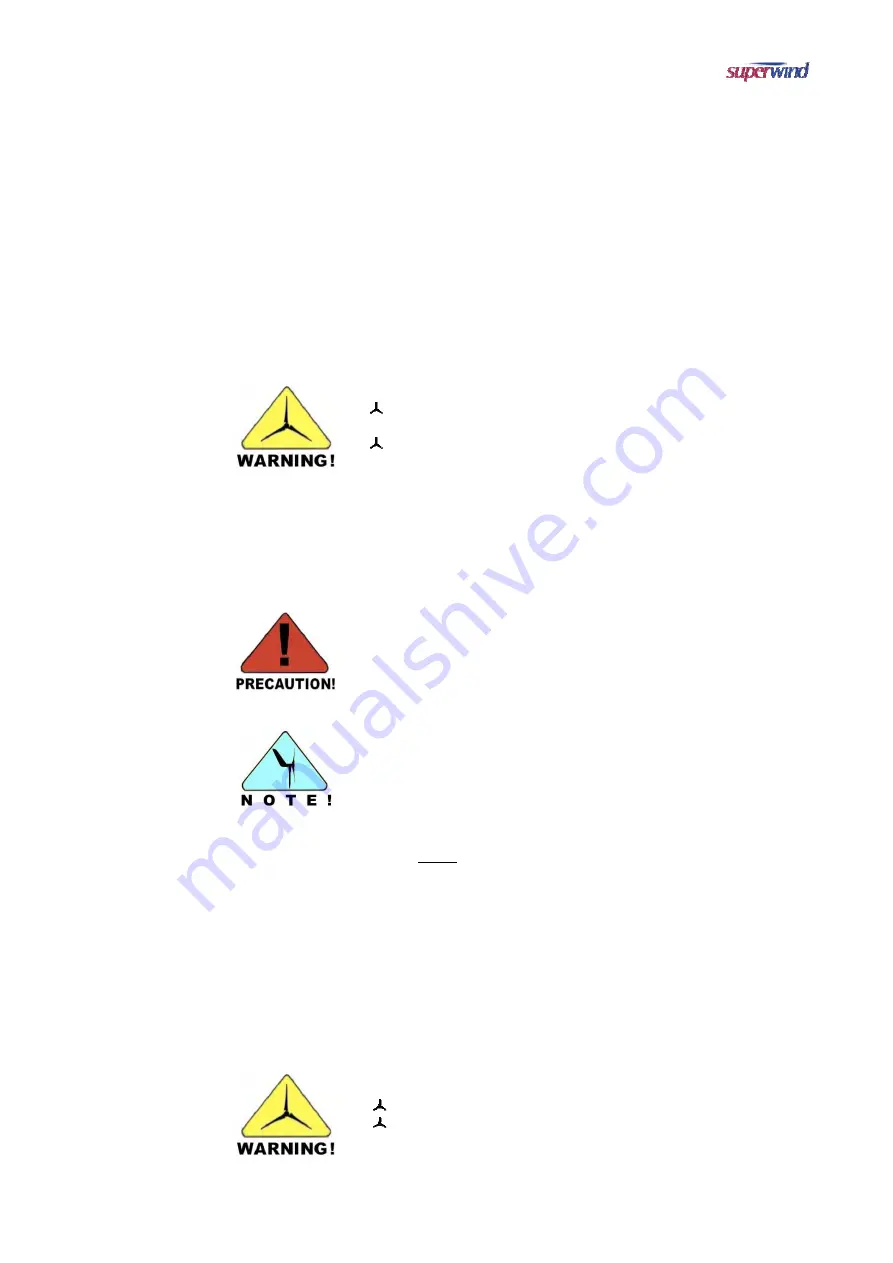
V 01-2017
www.superwind.com
23
Another important criteria for battery selection is the ‘capacity’, expressed
in ampere-hours (Ah). This value represents the quantity of storable
energy. The required capacity depends on your individual situation (wind
location, consumption structure, combination with other generators
sources like diesel, solar
etc.). Your battery dealer can assist you in
selecting a suitable battery.
When selecting battery location for an installation, refer to the battery
manufacturer’s instructions.
Charging lead-acid batteries produce potentially flammable hydrogen
gas. Unsealed lead-acid batteries have vent holes that also release
hydrogen, which forms potentially explosive gas in the surrounding
environment. A small spark (e.g. an electrical switch) can detonate this
explosive gas mixture. For explosion and fire prevention, always provide
sufficient ventilation for your battery bank.
Never install the batteries in places with a danger of flame or
spark formation.
Provide sufficient ventilation at all times.
Batteries store a large quantity of energy potential, which when suddenly
discharged (in the case of a short-circuit) can destroy the battery
(releasing battery acid and gas) and/or set the battery and wiring on fire!
Short-circuiting wires or batteries must be avoided in all cases. For this
reason battery terminal connections must only be made after all work on
the electric system has been completed.
NEVER SHORT-CIRCUIT THE BATTERY.
The battery terminals may be connected only after all work on
the electric system has been completed.
For protection against high voltage
spikes and/or an accidental short-
circuit event,
fuses
must be installed in the positive (+) wires to the
battery. See Section 6.3.5 on page 25 for fuses. See Graphic 6.2.1.1 for
connection diagram on page 18.
Since blowing a fuse or releasing an automatic circuit breaker can cause
an electrical spark, fuses and breakers must not be installed in the same
area as the battery.
Use extreme caution while handling battery acid, refilling with distilled
water or performing other maintenance on the batteries. Follow the
instructions of the battery manufacturer and wear protective clothing and
suitable eye protection.
Act with extreme caution while handling battery acid.
Wear protective clothing and suitable eye protection.
Summary of Contents for 350 12V
Page 1: ...www superwind com Superwind 350 12V 24V Manual North Central and South America regions 01 2017...
Page 2: ...V 01 2017 www superwind com 1 Page intentionally left blank...
Page 52: ...V 01 2017 www superwind com 51 ATTACHMENT A Stop Switch Mounting Guidelines...
Page 53: ...V 01 2017 www superwind com 52 STOP SWITCH Mounting Guidelines Manual 01 2017...
Page 60: ...V 01 2017 www superwind com 59 ATTACHMENT B Superwind Charge Regulator 12V Marine...
Page 61: ...V 01 2017 www superwind com 60 Charge Regulator 12V Marine Instructions Manual 01 2017...
Page 70: ...V 01 2017 www superwind com 69 ATTACHMENT C Superwind Charge Regulator 24V Marine...
Page 71: ...V 01 2017 www superwind com 70 Charge Regulator 24V Marine Instructions Manual...






























